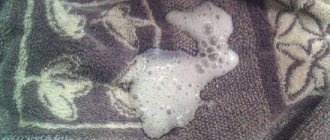Tetanus in dogs (Tetanus)
– a dangerous zoonotic infectious disease, an acute wound bacterial infection with a contact mechanism of transmission of a dangerous pathogen. The disease is caused by the action of the neurotropic toxin of the anaerobic bacillus Clostridium tetani (Clostridium tetani). The development of bacteria occurs in anaerobic environments, without access to oxygen. Bacterial infection is characterized by damage to the central nervous system, which is manifested by tonic tension of the skeletal muscles, convulsions, and muscle spasms. Late, untimely treatment of dogs, cats, and other pets can cause death.
Causes of tetanus, how a dog becomes infected
Clostridium tetani
– obligate gram-positive strict anaerobe 4-8 microns in length, forming spores, which explains the resistance of the pathogen to various environmental factors. Vegetative forms of bacteria are not very resistant to the effects of physicochemical factors. Clostridium tetani spores are resistant to some disinfectants, disinfectants, various environmental factors, and can withstand heating in humid environments up to 75-80 degrees. When boiled, they die within 45-50 minutes.
The bacterium produces a potent exotoxin, tetanospasmin (tetanus toxin), which is transported by the retrogard axoplasmic stream in the axon and also through synaptic junctions before reaching the central nervous system. The neurotoxin blocks the production of inhibitory neurotransmitters such as glycine, GABA (gamma-aminobutyric acid). In addition, clostridia produce tetanolysin, which destroys red blood cells (erythrocytes).
A dog becomes infected with tetanus toxin when the integrity of the skin is damaged. decreased protective function of the skin. The source of infection is soil contaminated with spores of anaerobic bacteria, as well as objects contaminated with soil. The causative agents of tetanus are found in high concentrations in soil, especially in manured, wet soil.
When it gets into deep, puncture, cut or lacerated wounds, bacteria actively multiply in dead tissues, releasing a neurotoxin that enters various parts of the central nervous system (CNS), producing a specific effect.
Burns, frostbite, gangrene, and closed contaminated wounds are a favorable environment for the development of anaerobic bacteria. Wounds that are not treated in time create favorable conditions for the penetration of clostridia spores.
What it is
This disease is nothing more than signs of damage to the nervous tissue by a neurotoxin that is synthesized by Clostridium tetani. Despite the comparative resistance to its effects in dogs (and cats, by the way, too), this pathology also occurs in them. It is interesting to know that the most “unsinkable” in this case are birds: the lethal dose of toxin for pigeons and chickens is 10,000-300,000 times greater (by body weight) than the lethal dose for horses.
As a rule, the pathogen enters the body through wounds, scratches and cuts of the limbs in contact with the soil. In winter, there are practically no cases of the disease. Young animals are most susceptible.
Symptoms of Tetanus in Dogs
Tetanus in dogs is characterized by complete or partial damage to various parts of the central nervous system, which is manifested by spastic muscle contractions, convulsions, paresis, and paralysis. The average incubation period is six to ten days. In this case, characteristic symptoms may appear several weeks after infection and spores penetrate the wounds.
Horses, cattle and humans are the most sensitive to tetanus, but among our smaller brothers there are also cases of diagnosing a dangerous infection, which manifests itself with a characteristic clinical picture - muscle rigidity at the site of injury. Predatory animals can also become infected with tetanus, although they are also quite resistant to tetanus toxin.
Tetanus in dogs develops in two forms:
- generalized;
- localized.
In the first case, all muscle structures are subject to convulsive contraction; in the localized form, a lesion is noted, a change in the tone of only one muscle group.
Symptoms of tetanus in dogs:
- increased fearfulness;
- inadequate response to external stimuli;
- tense gait;
- increased temperature during the manifestation of convulsions, muscle spasms;
- prolapse of the third eyelid;
- generalized lameness, stiffness of movement;
- refusal to feed, lack of appetite;
- abdominal distension;
- incoordination;
- painful urination;
- stiffness of the hind limbs in a generalized form of the disease;
- severe weight loss;
- dehydration (dehydration);
- spasms of the masticatory muscles, which makes it difficult to eat;
- complete, partial immobility of the jaws.
Dogs have difficulty swallowing, which leads to excessive drooling. As the disease progresses, head tension develops, dense, hard skin folds appear on the forehead and neck, paralysis of facial and masticatory muscles occurs, the jaw is clenched (trismus), which makes swallowing difficult and makes eating impossible. Dogs walk with their heads stretched out, their necks tense, their eyes motionless, their eyeballs protruding, their limbs spread out, unnaturally straightened, their tail raised, their ears folded over their heads. You may notice that dogs constantly look at only one point and throw their heads back (opisthotonus). In most cases, body temperature remains normal.
Important! Muscle paralysis leads to the fact that the dog cannot eat food or drink water on its own. The process of urination and defecation is difficult.
A sick dog is irritated by bright lights and loud, sharp sounds, which can manifest as inappropriate behavior. Noise and light intensify seizures and provoke tetanic muscle spasms. The death of a pet can occur in the event of asphyxia or severe intoxication.
In dogs, respiratory function is impaired, arrhythmia, ataxia, bradycardia, tachycardia, and cyanosis develop. Animals quickly get tired, try to hide in a dark, secluded corner, and react inadequately to external stimuli. With severe intoxication, dogs suffer from debilitating vomiting and frequent bouts of nausea.
Diagnostics
The diagnosis of tetanus in dogs is made on the basis of a comprehensive examination, characteristic clinical manifestations, and medical history. Be sure to carry out differential diagnosis to exclude rabies, pseudorabies (Aujeszky's disease), and strychnine poisoning.
If tetanus is suspected, blood is taken from dogs for a general, biochemical analysis, as well as a urine test. During a clinical blood test, the leukocyte formula will be changed, the number of leukocytes in the blood will increase - leukocytosis, which indicates the development of inflammatory processes. The concentration of creatine phosphokinase, an enzyme found in cardiac and skeletal muscles, increases in the blood. Tetanus toxin causes the destruction of red blood cells.
In urine tests, the presence of the muscle protein myoglobin is noted, which is obtained as a result of frequent contraction of muscle structures.
For analysis, wound fluid and fragments of damaged tissue are taken.
Etiology and pathogenesis
The causative agent of tetanus is found in soil, and clostridium is often found in the intestines of many animals. As we said, the development of the disease begins with the bacteria entering the wound. But! For tetanus to develop, the wound must not be exposed to air (anaerobic environment).
Most often, such damage occurs when the surface of a scratch becomes clogged with debris, ichor and pus. An operation performed without following all the rules of asepsis and antisepsis is also fraught with similar risks. In particular, in world veterinary practice there have been cases where castrated males fell ill with tetanus.
Treatment of tetanus in dogs
At the slightest suspicion that your dog has tetanus, immediately contact a veterinary clinic and call a veterinarian to your home. The life of your beloved pet depends on the efficiency of your actions. Until the veterinarian arrives, provide the dog with complete rest, do not disturb the pet, and turn off the bright lights. The dog should be in a quiet, calm place.
When diagnosing tetanus, long-term treatment of four-fingered patients in a hospital is required, which will take at least three to four weeks. When treating tetanus, animals are injected with a specific tetanus toxoid. Treatment methods are aimed at maintaining vital functions and creating the most comfortable conditions.
Since dogs cannot eat on their own, an intravenous catheter is placed through which saline solutions, glucose, pharmacological drugs, and vitamins are administered. Food may also be given through a special tube to introduce food directly into the stomach. If there is no urination, catheterization is performed and a urethral catheter is placed. Digestive processes are stimulated with enzyme preparations. If the animal cannot breathe, the animals are connected to a ventilator and a tracheostomy is installed.
To relieve pain, spasms, and relieve muscle cramps, dogs are prescribed analgesics, antispasmodics, and anti-inflammatory drugs. Treatment is by debridement of the dog's wounds, removal of dead tissue, followed by administration of anti-tetanus serum. For severe tonic spasms and convulsions, sedatives and anticonvulsants are prescribed in the form of injections. To maintain the general tone of the body, vitamins and glucose solution are administered subcutaneously.
During treatment, the treating veterinarian must constantly monitor the condition of the sick animal. After treatment, owners should monitor the dog’s condition and adjust the diet until digestive processes are completely normalized.
Diagnosis of the disease
No specific tests are performed to diagnose tetanus. Diagnosis is made based on clinical signs. It is possible to quantify antibodies against tetanus toxin, but this is not performed in a clinical setting.
Treatment will consist of the following:
- Fighting bacteria.
- Fighting toxins.
- Fighting muscle spasms.
- Combating hypersensitivity.
- Perform CPR and ensure good hydration.
- Provide good care.
Fighting bacteria: antibiotics
Metronidazole is used as an antibiotic to combat tetanus bacteria in dogs. The antibiotic kills bacteria, but not tetanus toxins.
Toxin Fighting: Tetanus Serum
Intravenous administration of equine tetanus serum is used to kill the toxins produced by the bacteria. This serum binds to toxins and destroys them.
However, there are two important points during treatment with this serum:
- This serum only acts on toxins that have not yet entered the nerve. For this reason, treatment should begin as soon as possible after the injury.
- Because this product is derived from another animal species (horse), intravenous injection can cause anaphylactic shock, sometimes with tragic consequences.
Before administering intravenous serum, an intradermal test should be performed to determine whether there is a reaction to this product.
Fighting muscle spasms: muscle relaxants
To control spasms, cramps, tremors, and muscle stiffness, your veterinarian will use the following types of muscle relaxants:
- Diazepam (Valium).
- Methocarbamol: a muscle relaxant to prevent respiratory arrest.
Combating hypersensitivity: sedatives
To relieve hypersensitivity to light and sound, a sedative is used: acepromazine.
Perform CPR and ensure good hydration
If the dog has difficulty breathing, artificial ventilation should be performed. Drip infusions will also be required if the animal has difficulty swallowing due to spasms of the larynx.
Preventing tetanus in dogs
Prevention of tetanus in dogs involves timely treatment of wounds with antiseptic agents. After each walk, carefully examine the dog’s skin for wounds, abrasions, and cuts.
It is equally important to monitor the quality of your diet. You should not give your dogs stale food or meat products of dubious origin. Make sure that during walks your four-legged friend does not pick up dangerous “delicacies” from the ground, so from puppyhood, pay attention to the upbringing and training of your pet.
Providing good care
Daily care can be lengthy and expensive. First of all, the animal should be placed in a dark and quiet room to avoid unnecessary stress, which could worsen its condition. A paralyzed dog needs to be repositioned regularly to prevent bedsores. It is recommended to regularly massage the muscles.
If your dog has difficulty swallowing or has a clenched (tight) jaw that prevents him from eating, a stomach tube will need to be inserted.











